Friday, September 19. 2014
Some experience with Content Security Policy
 I recently started playing around with Content Security Policy (CSP). CSP is a very neat feature and a good example how to get IT security right.
I recently started playing around with Content Security Policy (CSP). CSP is a very neat feature and a good example how to get IT security right.The main reason CSP exists are cross site scripting vulnerabilities (XSS). Every time a malicious attacker is able to somehow inject JavaScript or other executable code into your webpage this is called an XSS. XSS vulnerabilities are amongst the most common vulnerabilities in web applications.
CSP fixes XSS for good
The approach to fix XSS in the past was to educate web developers that they need to filter or properly escape their input. The problem with this approach is that it doesn't work. Even large websites like Amazon or Ebay don't get this right. The problem, simply stated, is that there are just too many places in a complex web application to create XSS vulnerabilities. Fixing them one at a time doesn't scale.
CSP tries to fix this in a much more generic way: How can we prevent XSS from happening at all? The way to do this is that the web server is sending a header which defines where JavaScript and other content (images, objects etc.) is allowed to come from. If used correctly CSP can prevent XSS completely. The problem with CSP is that it's hard to add to an already existing project, because if you want CSP to be really secure you have to forbid inline JavaScript. That often requires large re-engineering of existing code. Preferrably CSP should be part of the development process right from the beginning. If you start a web project keep that in mind and educate your developers to use restrictive CSP before they write any code. Starting a new web page without CSP these days is irresponsible.
To play around with it I added a CSP header to my personal webpage. This was a simple target, because it's a very simple webpage. I'm essentially sure that my webpage is XSS free because it doesn't use any untrusted input, I mainly wanted to have an easy target to do some testing. I also tried to add CSP to this blog, but this turned out to be much more complicated.
For my personal webpage this is what I did (PHP code):
header("Content-Security-Policy:default-src 'none';img-src 'self';style-src 'self';report-uri /c/");
The default policy is to accept nothing. The only things I use on my webpage are images and stylesheets and they all are located on the same webspace as the webpage itself, so I allow these two things.
This is an extremely simple CSP policy. To give you an idea how a more realistic policy looks like this is the one from Github:
Content-Security-Policy: default-src *; script-src assets-cdn.github.com www.google-analytics.com collector-cdn.github.com; object-src assets-cdn.github.com; style-src 'self' 'unsafe-inline' 'unsafe-eval' assets-cdn.github.com; img-src 'self' data: assets-cdn.github.com identicons.github.com www.google-analytics.com collector.githubapp.com *.githubusercontent.com *.gravatar.com *.wp.com; media-src 'none'; frame-src 'self' render.githubusercontent.com gist.github.com www.youtube.com player.vimeo.com checkout.paypal.com; font-src assets-cdn.github.com; connect-src 'self' ghconduit.com:25035 live.github.com uploads.github.com s3.amazonaws.com
Reporting feature
You may have noticed in my CSP header line that there's a "report-uri" command at the end. The idea is that whenever a browser blocks something by CSP it is able to report this to the webpage owner. Why should we do this? Because we still want to fix XSS issues (there are browsers with little or no CSP support (I'm looking at you Internet Explorer) and we want to know if our policy breaks anything that is supposed to work. The way this works is that a json file with details is sent via a POST request to the URL given.
While this sounds really neat in theory, in practise I found it to be quite disappointing. As I said above I'm almost certain my webpage has no XSS issues, so I shouldn't get any reports at all. However I get lots of them and they are all false positives. The problem are browser extensions that execute things inside a webpage's context. Sometimes you can spot them (when source-file starts with "chrome-extension" or "safari-extension"), sometimes you can't (source-file will only say "data"). Sometimes this is triggered not by single extensions but by combinations of different ones (I found out that a combination of HTTPS everywhere and Adblock for Chrome triggered a CSP warning). I'm not sure how to handle this and if this is something that should be reported as a bug either to the browser vendors or the extension developers.
Conclusion
If you start a web project use CSP. If you have a web page that needs extra security use CSP (my bank doesn't - does yours?). CSP reporting is neat, but it's usefulness is limited due to too many false positives.
Then there's the bigger picture of IT security in general. Fixing single security bugs doesn't work. Why? XSS is as old as JavaScript (1995) and it's still a huge problem. An example for a simliar technology are prepared statements for SQL. If you use them you won't have SQL injections. SQL injections are the second most prevalent web security problem after XSS. By using CSP and prepared statements you eliminate the two biggest issues in web security. Sounds like a good idea to me.
Buffer overflows where first documented 1972 and they still are the source of many security issues. Fixing them for good is trickier but it is also possible.
Tuesday, August 5. 2014
Las Vegas
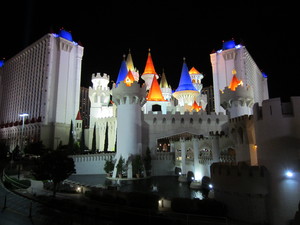
My hotel looks like a Disneyland castle - just much larger.
Las Vegas is probably a place I would've never visited on its own. I consider myself a rationalist person and therefore I see gambling mostly as an illogical pursuit. In the end your chances of winning are minimal because otherwise the business wouldn't work. I hadn't imagined how huge the casino business in Las Vegas is. Large parts of the city are just one large casino after another - and it doesn't stop there, because a couple of cities around Vegas literally are made of casinos.
Beside seeing some of the usual tourist attractions (Hoover Dam, Lake Mead), I spend the last couple of days also finding out that there are some interesting solar energy projects nearby. Also a large Star Trek convention> was happening the past days where I attended on the last day.

A Nintendo test cardrige at A Gamer's Paradise
Pictures from Las Vegas
Pictures from A Gamer's Paradise
Pictures from Pinball Hall of Fame
Posted by Hanno Böck
in Computer culture, English, Life, Retro Games
at
07:39
| Comment (1)
| Trackbacks (0)
Saturday, July 12. 2014
LibreSSL on Gentoo
 Yesterday the LibreSSL project released the first portable version that works on Linux. LibreSSL is a fork of OpenSSL and was created by the OpenBSD team in the aftermath of the Heartbleed bug.
Yesterday the LibreSSL project released the first portable version that works on Linux. LibreSSL is a fork of OpenSSL and was created by the OpenBSD team in the aftermath of the Heartbleed bug.Yesterday and today I played around with it on Gentoo Linux. I was able to replace my system's OpenSSL completely with LibreSSL and with few exceptions was able to successfully rebuild all packages using OpenSSL.
After getting this running on my own system I installed it on a test server. The Webpage tlsfun.de runs on that server. The functionality changes are limited, the only thing visible from the outside is the support for the experimental, not yet standardized ChaCha20-Poly1305 cipher suites, which is a nice thing.
A warning ahead: This is experimental, in no way stable or supported and if you try any of this you do it at your own risk. Please report any bugs you have with my overlay to me or leave a comment and don't disturb anyone else (from Gentoo or LibreSSL) with it. If you want to try it, you can get a portage overlay in a subversion repository. You can check it out with this command:
svn co https://svn.hboeck.de/libressl-overlay/
git clone https://github.com/gentoo/libressl.git
This is what I had to do to get things running:
LibreSSL itself
First of all the Gentoo tree contains a lot of packages that directly depend on openssl, so I couldn't just replace that. The correct solution to handle such issues would be to create a virtual package and change all packages depending directly on openssl to depend on the virtual. This is already discussed in the appropriate Gentoo bug, but this would mean patching hundreds of packages so I skipped it and worked around it by leaving a fake openssl package in place that itself depends on libressl.
LibreSSL deprecates some APIs from OpenSSL. The first thing that stopped me was that various programs use the functions RAND_egd() and RAND_egd_bytes(). I didn't know until yesterday what egd is. It stands for Entropy Gathering Daemon and is a tool written in perl meant to replace the functionality of /dev/(u)random on non-Linux-systems. The LibreSSL-developers consider it insecure and after having read what it is I have to agree. However, the removal of those functions causes many packages not to build, upon them wget, python and ruby. My workaround was to add two dummy functions that just return -1, which is the error code if the Entropy Gathering Daemon is not available. So the API still behaves like expected. I also posted the patch upstream, but the LibreSSL devs don't like it. So on the long term it's probably better to fix applications to stop trying to use egd, but for now these dummy functions make it easier for me to build my system.
The second issue popping up was that the libcrypto.so from libressl contains an undefined main() function symbol which causes linking problems with a couple of applications (subversion, xorg-server, hexchat). According to upstream this undefined symbol is intended and most likely these are bugs in the applications having linking problems. However, for now it was easier for me to patch the symbol out instead of fixing all the apps. Like the egd issue on the long term fixing the applications is better.
The third issue was that LibreSSL doesn't ship pkg-config (.pc) files, some apps use them to get the correct compilation flags. I grabbed the ones from openssl and adjusted them accordingly.
OpenSSH
This was the most interesting issue from all of them.
To understand this you have to understand how both LibreSSL and OpenSSH are developed. They are both from OpenBSD and they use some functions that are only available there. To allow them to be built on other systems they release portable versions which ship the missing OpenBSD-only-functions. One of them is arc4random().
Both LibreSSL and OpenSSH ship their compatibility version of arc4random(). The one from OpenSSH calls RAND_bytes(), which is a function from OpenSSL. The RAND_bytes() function from LibreSSL however calls arc4random(). Due to the linking order OpenSSH uses its own arc4random(). So what we have here is a nice recursion. arc4random() and RAND_bytes() try to call each other. The result is a segfault.
I fixed it by using the LibreSSL arc4random.c file for OpenSSH. I had to copy another function called arc4random_stir() from OpenSSH's arc4random.c and the header file thread_private.h. Surprisingly, this seems to work flawlessly.
Net-SSLeay
This package contains the perl bindings for openssl. The problem is a check for the openssl version string that expected the name OpenSSL and a version number with three numbers and a letter (like 1.0.1h). LibreSSL prints the version 2.0. I just hardcoded the OpenSSL version numer, which is not a real fix, but it works for now.
SpamAssassin
SpamAssassin's code for spamc requires SSLv2 functions to be available. SSLv2 is heavily insecure and should not be used at all and therefore the LibreSSL devs have removed all SSLv2 function calls. Luckily, Debian had a patch to remove SSLv2 that I could use.
libesmtp / gwenhywfar
Some DES-related functions (DES is the old Data Encryption Standard) in OpenSSL are available in two forms: With uppercase DES_ and with lowercase des_. I can only guess that the des_ variants are for backwards compatibliity with some very old versions of OpenSSL. According to the docs the DES_ variants should be used. LibreSSL has removed the des_ variants.
For gwenhywfar I wrote a small patch and sent it upstream. For libesmtp all the code was in ntlm. After reading that ntlm is an ancient, proprietary Microsoft authentication protocol I decided that I don't need that anyway so I just added --disable-ntlm to the ebuild.
Dovecot
In Dovecot two issues popped up. LibreSSL removed the SSL Compression functionality (which is good, because since the CRIME attack we know it's not secure). Dovecot's configure script checks for it, but the check doesn't work. It checks for a function that LibreSSL keeps as a stub. For now I just disabled the check in the configure script. The solution is probably to remove all remaining stub functions. The configure script could probably also be changed to work in any case.
The second issue was that the Dovecot code has some #ifdef clauses that check the openssl version number for the ECDH auto functionality that has been added in OpenSSL 1.0.2 beta versions. As the LibreSSL version number 2.0 is higher than 1.0.2 it thinks it is newer and tries to enable it, but the code is not present in LibreSSL. I changed the #ifdefs to check for the actual functionality by checking a constant defined by the ECDH auto code.
Apache httpd
The Apache http compilation complained about a missing ENGINE_CTRL_CHIL_SET_FORKCHECK. I have no idea what it does, but I found a patch to fix the issue, so I didn't investigate it further.
Further reading:
Someone else tried to get things running on Sabotage Linux.
Update: I've abandoned my own libressl overlay, a LibreSSL overlay by various Gentoo developers is now maintained at GitHub.
Posted by Hanno Böck
in Code, Cryptography, English, Gentoo, Linux, Security
at
20:31
| Comments (8)
| Trackbacks (5)
Wednesday, June 18. 2014
Should science journalists read the studies they write about?
Today I had a little twitter conversation which made me think about the responsibilities a science journalist has. It all started with a quote from Ivan Oransky (who is the editor of Retraction Watch) who said reporting on a study without reading it is 'journalist malpractice'. The source of this is another person who probably just heard him saying that, so I'm not sure what his exact words were.
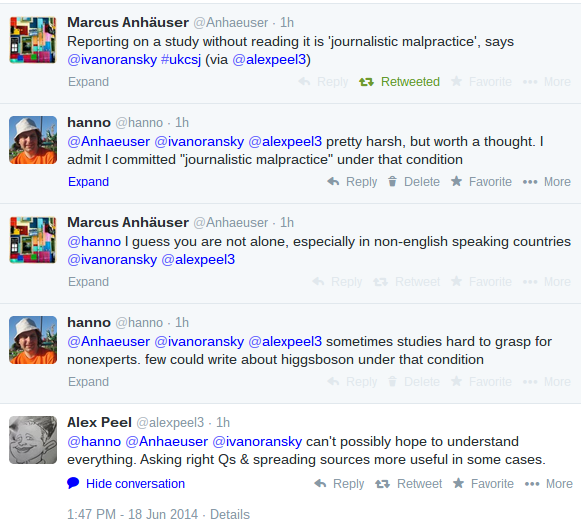
Admittedly my first thought was: "He is right, too many journalists report about things they don't understand." My second thought was: "If he is right then I am probably guilty of 'journalist malpractice'." So I gave it a second thought and I probably won't agree with the statement any more.
I had a quick look at articles I wrote in the past and I have identified the last ten ones that more or less were coverages of a scientific piece of work. I have marked the ones I actually read with a [Y] and the ones I didn't read with a [N]. I've linked the appropriate scientific works and my articles (all in German). I must admit that I defined "read" widely, meaning that I haven't neccesarrily read the whole study/article in detail, I sometimes have just tried to parse the important parts for me.
Now the first thing that comes to mind is that I seem to have become lazier recently in reading studies. I hope this isn't the case and I hoestly think this is mostly coincidence. Now let's get into some details: The first example (the Turing Test) is interesting because it seems there is no scientific publication at all, just a press release. This probably tells you something about the quality of that "research", but while I read the press release I haven't even bothered to check if there is a scientific publication I could read.
The second example becomes interesting. I understand enough to know what a "quasi-polynomial algorithm for discrete logarithm in finite fields of small characteristic" actually is and I think I also understand what it means, but there's just no way I could understand the paper itself. This is complex mathematics. I seriously doubt that any journalist who covered this work actually read it. If there is I'd like to meet that person. I'm also very sure that the people who wrote the press release overselling this research have neither read this paper nor understood its implications.
I think this example gets to the point why I would disagree with the very general statement that a journalist should've read every scientific piece he writes about: It's sometimes so specialized that it's basically impossible. And I don't think this is an out of the line example. Just think about the Higgs Boson: Certainly this is something we want journalists to write about. But I'm pretty sure there are very few - if any - journalists who are able to read the scientific publications that are the basis of this discovery.
Some quick notes on the others: Number 4 was part of a 200-page-thesis and the press release was already pretty detailed and technically, I think it was legitimate to not read the original source in that case. Number 5 is somewhat similar to 2, because it is about an algorithm that includes complex math. Number 8 is not really a scientific paper, it is merely a news item on the Nature webpage. In the above list, the only case where I think maybe I should've read the scientific paper and I didn't is the Cochrane-Review on Tamiflu.
Conclusion: Don't get me wrong. I certainly welcome the idea that science journalists should have a look into the original scientific papers they write about more often - and this doesn't exclude myself. However, as shown above I doubt that this works in all cases.

Admittedly my first thought was: "He is right, too many journalists report about things they don't understand." My second thought was: "If he is right then I am probably guilty of 'journalist malpractice'." So I gave it a second thought and I probably won't agree with the statement any more.
I had a quick look at articles I wrote in the past and I have identified the last ten ones that more or less were coverages of a scientific piece of work. I have marked the ones I actually read with a [Y] and the ones I didn't read with a [N]. I've linked the appropriate scientific works and my articles (all in German). I must admit that I defined "read" widely, meaning that I haven't neccesarrily read the whole study/article in detail, I sometimes have just tried to parse the important parts for me.
- [X] Supposedly successful Turing Test taz, 2014-06-13
- [N]A quasi-polynomial algorithm for discrete logarithm in finite fields of small characteristic, Golem.de, 2014-05-17
- [N] Neuraminidase inhibitors for preventing and treating influenza in healthy adults and children (Cochrane-Review on Tamiflu), Neues Deutschland, 2014-04-26)
- [N] 20 Years of SSL/TLS Research: An Analysis of the Internet's Security Foundation, Golem.de, 2014-04-17
- [N] DRAFT FIPS 202 - SHA-3 Standard: Permutation-Based Hash and Extendable-Output Functions, Golem, 2014-04-05
- [Y] Using Frankencerts for Automated Adversarial Testing of Certificate Validation in SSL/TLS Implementations, Golem.de, 2014-04-04
- [Y] On the Practical Exploitability of Dual EC in TLS Implementations, Golem.de, 2014-04-01
- [Y] Publishers withdraw more than 120 gibberish papers, Golem.de, 2014-02-27
- [Y] Completeness of Reporting of Patient-Relevant Clinical Trial Outcomes: Comparison of Unpublished Clinical Study Reports with Publicly Available Data, taz, 2013-10-18
- [Y] Factoring RSA keys from certified smart cards: Coppersmith in the wild, Golem.de, 2013-09-17
Now the first thing that comes to mind is that I seem to have become lazier recently in reading studies. I hope this isn't the case and I hoestly think this is mostly coincidence. Now let's get into some details: The first example (the Turing Test) is interesting because it seems there is no scientific publication at all, just a press release. This probably tells you something about the quality of that "research", but while I read the press release I haven't even bothered to check if there is a scientific publication I could read.
The second example becomes interesting. I understand enough to know what a "quasi-polynomial algorithm for discrete logarithm in finite fields of small characteristic" actually is and I think I also understand what it means, but there's just no way I could understand the paper itself. This is complex mathematics. I seriously doubt that any journalist who covered this work actually read it. If there is I'd like to meet that person. I'm also very sure that the people who wrote the press release overselling this research have neither read this paper nor understood its implications.
I think this example gets to the point why I would disagree with the very general statement that a journalist should've read every scientific piece he writes about: It's sometimes so specialized that it's basically impossible. And I don't think this is an out of the line example. Just think about the Higgs Boson: Certainly this is something we want journalists to write about. But I'm pretty sure there are very few - if any - journalists who are able to read the scientific publications that are the basis of this discovery.
Some quick notes on the others: Number 4 was part of a 200-page-thesis and the press release was already pretty detailed and technically, I think it was legitimate to not read the original source in that case. Number 5 is somewhat similar to 2, because it is about an algorithm that includes complex math. Number 8 is not really a scientific paper, it is merely a news item on the Nature webpage. In the above list, the only case where I think maybe I should've read the scientific paper and I didn't is the Cochrane-Review on Tamiflu.
Conclusion: Don't get me wrong. I certainly welcome the idea that science journalists should have a look into the original scientific papers they write about more often - and this doesn't exclude myself. However, as shown above I doubt that this works in all cases.
Posted by Hanno Böck
in Cryptography, English, Science
at
15:03
| Comments (0)
| Trackbacks (0)
Defined tags for this entry: journalism, science
Sunday, June 15. 2014
Slides from cryptography workshop for web developers
I recently held a workshop about cryptography for web developers at the company Internations. I am publishing the slides here.
Part 1: Crypto and Web [PDF] [LaTeX], [Slideshare]
Part 2: How broken is TLS? [PDF] [LaTeX], [Slideshare]
Part 3: Don't do this yourself [PDF] [LaTeX], [Slideshare]
Part 4: Hashing, Tokens, Randomness [PDF] [LaTeX], [Slideshare]
Part 5: Don't believe the Crypto Hype [PDF] [LaTeX] [Slideshare]
Part 2 is the same talk I recently have at the Easterhegg conference about TLS.
Part 1: Crypto and Web [PDF] [LaTeX], [Slideshare]
Part 2: How broken is TLS? [PDF] [LaTeX], [Slideshare]
Part 3: Don't do this yourself [PDF] [LaTeX], [Slideshare]
Part 4: Hashing, Tokens, Randomness [PDF] [LaTeX], [Slideshare]
Part 5: Don't believe the Crypto Hype [PDF] [LaTeX] [Slideshare]
Part 2 is the same talk I recently have at the Easterhegg conference about TLS.
Posted by Hanno Böck
in Code, Cryptography, English, Security
at
13:49
| Comments (0)
| Trackbacks (0)
Defined tags for this entry: crypto, cryptography, http, https, security, ssl, tls, web, websecurity
Friday, June 6. 2014
Enabling encryption by default and using HTTPS only
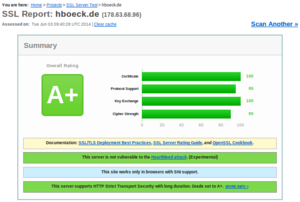 I recently switched my personal web page and my blog to deliver content exclusively encrypted via HTTPS. I want to take this opportunity to give some facts about enabling TLS encryption by default and problems you may face.
I recently switched my personal web page and my blog to deliver content exclusively encrypted via HTTPS. I want to take this opportunity to give some facts about enabling TLS encryption by default and problems you may face.First of all the non-problems: Enabling HTTPS by default is almost never a significant performance problem. If people tell me that they can not possibly enable HTTPS due to performance reasons the first thing I ask is if they believe this or if they have real benchmark data showing this. If you don't believe me on that, I can quote Adam Langley from Google here: "In January this year (2010), Gmail switched to using HTTPS for everything by default. Previously it had been introduced as an option, but now all of our users use HTTPS to secure their email between their browsers and Google, all the time. In order to do this we had to deploy no additional machines and no special hardware. On our production frontend machines, SSL/TLS accounts for less than 1% of the CPU load, less than 10KB of memory per connection and less than 2% of network overhead."
Enabling HTTPS may cause a number of compatibility issues you may not instantly think about. First of all, we know that IPs in the IPv4 space are limited and expensive these days, so many people probably can't afford having a distinct IP for their web page. The solution to that is a TLS extension called SNI (Server Name Indication) which allows to have different certificates for different domain names on the same IP. It works in all major browsers and has been working for quite some time. The only major browser you'll face these days that doesn't support SNI is the Android 2.x browser.
There are some subtle issues with SNI. One is that browsers have fallback modes if they cannot connect via TLS and that may lead to a connection downgrade to SSLv3. And that ancient protocol doesn't support extensions and thus no SNI. So you may have irregular certificate errors if you are on a bad connection. A solution to that on the server side is to just disable SSLv3. It will make SNI much more reliable.
I don't really have a clear picture how many browsers will fail with SNI. There are probably a number of embedded devices out there like smart TVs with browsers or things alike that have problems. If you have any experiences feel free to post them in the comments.
The first issue I only noticed after I switched to HTTPS: I had an application called RSS Graffiti set up to automatically post all articles I write to a facebook fan page. After changing to HTTPS only it silently stopped working. Re-adding my feed didn't work. I now found a similar service called dlvr.it that I now use to post my RSS feed to facebook. I can only assume that this is a glimpse of a much bigger problem: There are probably tons of applications and online services out there not prepared for an encrypted Internet. If we want more people to deploy encryption by default we need to find these issues, document them and hopefully put enough pressure on their developers to fix them.
Another yet unfixed issue is the Yandex Bot. Yandex is a search engine and although you may never have heard of it it's probably one of the few companies in this area that can claim to be a serious competitor to Google. The reason you may not know it is that it's mostly operating in Russian language. Depending on who your page visitors are this may matter more or less.
The Yandex Bot speaks SSL but according to the Qualys SSL test it only supports the ancient SSLv3. So you have a choice between three possibilities: Don't enable HTTPS by default, enable HTTPS with a shitty configuration supporting ancient technology that will cause trouble for SNI or enable HTTPS with a sane configuration and get no traffic from the leading Russian search engine. None of them sounds very good to me.
Another issue is third party content. For security reasons today's browsers block all active HTTP content (CSS, JavaScript etc.) on HTTPS webpages. This isn't much of a problem for me, but it's a problem for webpages that rely on advertising because from what I hear most advertisement providers don't support HTTPS yet (Google being a laudable exception here). This is the main reason you won't see many news webpages enforcing HTTPS. However, I still have passive third party HTTP content on my blog. That's why you'll probably see a yellow warning sign in front of the URL in some browsers.
Tuesday, April 29. 2014
Incomplete Certificate Chains and Transvalid Certificates
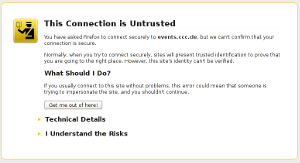 A number of people seem to be confused how to correctly install certificate chains for TLS servers. This happens quite often on HTTPS sites and to avoid having to explain things again and again I thought I'd write up something so I can refer to it. A few days ago flattr.com had a missing certificate chain (fixed now after I reported it) and various pages from the Chaos Computer Club have no certificate chain (not the main page, but several subdomains like events.ccc.de and frab.cccv.de). I've tried countless times to tell someone, but the problem persists. Maybe someone in charge will read this and fix it.
A number of people seem to be confused how to correctly install certificate chains for TLS servers. This happens quite often on HTTPS sites and to avoid having to explain things again and again I thought I'd write up something so I can refer to it. A few days ago flattr.com had a missing certificate chain (fixed now after I reported it) and various pages from the Chaos Computer Club have no certificate chain (not the main page, but several subdomains like events.ccc.de and frab.cccv.de). I've tried countless times to tell someone, but the problem persists. Maybe someone in charge will read this and fix it.Web browsers ship a list of certificate authorities (CAs) that are allowed to issue certificates for HTTPS websites. The whole system is inherently problematic, but right now that's not the point I want to talk about. Most of the time, people don't get their certificate from one of the root CAs but instead from a subordinate CA. Every CA is allowed to have unlimited numbers of sub CAs.
The correct way of delivering a certificate issued by a sub CA is to deliver both the host certificate and the certificate of the sub CA. This is neccesarry so the browser can check the complete chain from the root to the host. For example if you buy your certificate from RapidSSL then the RapidSSL cert is not in the browser. However, the RapidSSL certificate is signed by GeoTrust and that is in your browser. So if your HTTPS website delivers both its own certificate by RapidSSL and the RapidSSL certificate, the browser can validate the whole chain.
However, and here comes the tricky part: If you forget to deliver the chain certificate you often won't notice. The reason is that browsers cache chain certificates. In our example above if a user first visits a website with a certificate from RapidSSL and the correct chain the browser will already know the RapidSSL certificate. If the user then surfs to a page where the chain is missing the browser will still consider the certificate as valid. Such certificates with missing chain have been called transvalid, I think the term was first used by the EFF for their SSL Observatory.
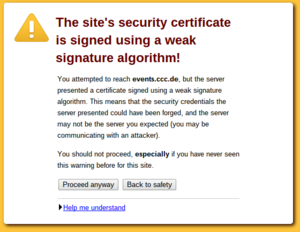
Chromium with bogus error message on a transvalid certificate
So how can you check if you have a transvalid certificate? One way is to use a fresh browser installation without anything cached. If you then surf to a page with a transvalid certificate, you'll get an error message (however, as we've just seen, not neccessarily a meaningful one). An easier way is to use the SSL Test from Qualys. It has a line "Chain issues" and if it shows "None" you're fine. If it shows "Incomplete" then your certificate is most likely transvalid. If it shows anything else you have other things to look after (a common issues is that people unneccesarily send the root certificate, which doesn't cause issues but may make things slower). The Qualys test test will tell you all kinds of other things about your TLS configuration. If it tells you something is insecure you should probably look after that, too.
Posted by Hanno Böck
in Cryptography, English, Linux, Security
at
14:29
| Comment (1)
| Trackback (1)
Thursday, April 24. 2014
Easterhegg talk on TLS
 Last weekend I was at the Easterhegg in Stuttgart, an event organized by the Chaos Computer Club. I had a talk with the title "How broken is TLS?"
Last weekend I was at the Easterhegg in Stuttgart, an event organized by the Chaos Computer Club. I had a talk with the title "How broken is TLS?"This was quite a lucky topic. I submitted the talk back in January, so I had no idea that the Heartbleed bug would turn up and raise the interest that much. However, it also made me rework large parts of the talk, because after Heartbleed I though I had to get a much broader view on the issues. The slides are here as PDF, here as LaTeX and here on Slideshare.
There's also a video recording here (media.ccc.de) and also on Youtube.
I also had a short lightning talk with some thoughs on paperless life, however it's only in German. Slides are here (PDF), here (LaTeX) and here (Slideshare). (It seems there is no video recording, if it appears later I'll add the link.)
Posted by Hanno Böck
in Computer culture, Cryptography, English, Life, Security
at
16:37
| Comments (0)
| Trackback (1)
Defined tags for this entry: ccc, cryptography, easterhegg, papierlos, security, slides, ssl, stuttgart, talk, tls
Monday, April 14. 2014
Freelance Journalist looking for Jobs
If you don't know who I am and what I do, let me quickly introduce myself:
I live in Berlin and work as a freelance journalist. I sometimes write for the newspapers taz, the online version of the Zeit and I'm a regular author at the IT news magazine Golem.de. Currently, my main topics are IT security and cryptography. I cover those topics both for general interest media and for experts. I also write about some completely different topics like climate change, energy politics, science and problems in medicine and whatever I happen to find interesting. I maintain an extensive list of articles I wrote in the past on my website and just recently added an English version with Google Translate links to my articles.
A notable article I wrote lately was a large piece on the security of various encryption algorithms after the Snowden revelations which got around 900.000 visits. In the past days I covered the Heartbleed story extensively and am happy to say that I wrote the first article in German language that appeared on Google News.
I'm quite happy with my job right now. Especially my cooperation with Golem.de is going very well. I have enough topics to write about, have some new opportunities in sight and earn enough money from my work to pay my expenses However, all my current employers publish exclusively in German. I sometimes cover topics where I'd wish that I could target an international audience and where I'd like to publish in English language.
If you are working for any kind of media in English language and you think my work may be interesting for you: Please get in touch with me. Of course if you work for any kind of media in German language and think the same you may also get in touch with me.
I'm aware that this is difficult. Anyone who decides to cooperate with me on this needs to be aware: I'm no native speaker. I think my English language skills are decent, but they are far from perfect. My work probably requires more spell checking and editing than others.
I live in Berlin and work as a freelance journalist. I sometimes write for the newspapers taz, the online version of the Zeit and I'm a regular author at the IT news magazine Golem.de. Currently, my main topics are IT security and cryptography. I cover those topics both for general interest media and for experts. I also write about some completely different topics like climate change, energy politics, science and problems in medicine and whatever I happen to find interesting. I maintain an extensive list of articles I wrote in the past on my website and just recently added an English version with Google Translate links to my articles.
A notable article I wrote lately was a large piece on the security of various encryption algorithms after the Snowden revelations which got around 900.000 visits. In the past days I covered the Heartbleed story extensively and am happy to say that I wrote the first article in German language that appeared on Google News.
I'm quite happy with my job right now. Especially my cooperation with Golem.de is going very well. I have enough topics to write about, have some new opportunities in sight and earn enough money from my work to pay my expenses However, all my current employers publish exclusively in German. I sometimes cover topics where I'd wish that I could target an international audience and where I'd like to publish in English language.
If you are working for any kind of media in English language and you think my work may be interesting for you: Please get in touch with me. Of course if you work for any kind of media in German language and think the same you may also get in touch with me.
I'm aware that this is difficult. Anyone who decides to cooperate with me on this needs to be aware: I'm no native speaker. I think my English language skills are decent, but they are far from perfect. My work probably requires more spell checking and editing than others.
Wednesday, March 26. 2014
Extract base64-encoded images from CSS
I recently stepped upon a webpage where I wanted to extract an image. However, after saving the page with my browser I couldn't find any JPG or PNG file. After looking into this, I saw some CSS code that looked like this:
background-image:url("data:image/jpeg;base64,iVBORw0KGgoAAAANSUhEUgAAACAAAAAgAQAAAABbAUdZAAAAE0lEQVR4AWNgYPj/n4oElU1jAADtvT/BfzVwSgAAAABJRU5ErkJggg==";
What this does is that it embeds a base64 encoded image file into the CSS layout. I found some tools to create such images, but I found none to extract them. It isn't very hard to extract such an image, I wrote a small bash script that will do and that I'd like to share:
Hope this helps others. If this script is copyrightable at all (which I doubt), I hereby release it (like the other content of my blog) as CC0 / Public Domain.
background-image:url("data:image/jpeg;base64,iVBORw0KGgoAAAANSUhEUgAAACAAAAAgAQAAAABbAUdZAAAAE0lEQVR4AWNgYPj/n4oElU1jAADtvT/BfzVwSgAAAABJRU5ErkJggg==";
What this does is that it embeds a base64 encoded image file into the CSS layout. I found some tools to create such images, but I found none to extract them. It isn't very hard to extract such an image, I wrote a small bash script that will do and that I'd like to share:
#!/bin/shSave this as css2base64 and pass HTML or CSS files on the command line (e. g. css2base64 test.html test.css).
n=1
for i in `grep -ho "base64,[A-Za-z0-9+/=]*" $@|sed -e "s:base64,::g"`; do
echo $i | base64 -d > file_$n
n=`expr $n + 1`
done
Hope this helps others. If this script is copyrightable at all (which I doubt), I hereby release it (like the other content of my blog) as CC0 / Public Domain.
Thursday, March 6. 2014
Diffie Hellman and TLS with nonsense parameters
tl;dr A very short key exchange crashes Chromium/Chrome. Other browsers accept parameters for a Diffie Hellman key exchange that are completely nonsense. In combination with recently found TLS problems this could be a security risk.
People who tried to access the webpage https://demo.cmrg.net/ recently with a current version of the Chrome browser or its free pendant Chromium have experienced that it causes a crash in the Browser. On Tuesday this was noted on the oss-security mailing list. The news spread quickly and gave this test page some attention. But the page was originally not set up to crash browsers. According to a thread on LWN.net it was set up in November 2013 to test extremely short parameters for a key exchange with Diffie Hellman. Diffie Hellman can be used in the TLS protocol to establish a connection with perfect forward secrecy.
For a key exchange with Diffie Hellman a server needs two parameters, those are transmitted to the client on a connection attempt: A large prime and a so-called generator. The size of the prime defines the security of the algorithm. Usually, primes with 1024 bit are used today, although this is not very secure. Mostly the Apache web server is responsible for this, because before the very latest version 2.4.7 it was not able to use longer primes for key exchanges.
The test page mentioned above tries a connection with 16 bit - extremely short - and it seems it has caught a serious bug in chromium. We had a look how other browsers handle short or nonsense key exchange parameters.
Mozilla Firefox rejects connections with very short primes like 256 bit or shorter, but connections with 512 and 768 bit were possible. This is completely insecure today. When the Chromium crash is prevented with a patch that is available it has the same behavior. Both browsers use the NSS library that blocks connections with very short primes.
The test with the Internet Explorer was a bit difficult because usually the Microsoft browser doesn't support Diffie Hellman key exchanges. It is only possible if the server certificate uses a DSA key with a length of 1024 bit. DSA keys for TLS connections are extremely rare, most certificate authorities only support RSA keys and certificates with 1024 bit usually aren't issued at all today. But we found that CAcert, a free certificate authority that is not included in mainstream browsers, still allows DSA certificates with 1024 bit. The Internet Explorer allowed only connections with primes of 512 bit or larger. Interestingly, Microsoft's browser also rejects connections with 2048 and 4096 bit. So it seems Microsoft doesn't accept too much security. But in practice this is mostly irrelevant, with common RSA certificates the Internet Explorer only allows key exchange with elliptic curves.
Opera is stricter than other browsers with short primes. Connections below 1024 bit produce a warning and the user is asked if he really wants to connect. Other browsers should probably also reject such short primes. There are no legitimate reasons for a key exchange with less than 1024 bit.
The behavior of Safari on MacOS and Konqueror on Linux was interesting. Both browsers accepted almost any kind of nonsense parameters. Very short primes like 17 were accepted. Even with 15 as a "prime" a connection was possible.
No browser checks if the transmitted prime is really a prime. A test connection with 1024 bit which used a prime parameter that was non-prime was possible with all browsers. The reason is probably that testing a prime is not trivial. To test large primes the Miller-Rabin test is used. It doesn't provide a strict mathematical proof for primality, only a very high probability, but in practice this is good enough. A Miller-Rabin test with 1024 bit is very fast, but with 4096 bit it can take seconds on slow CPUs. For a HTTPS connection an often unacceptable delay.
At first it seems that it is irrelevant if browsers accept insecure parameters for a key exchange. Usually this does not happen. The only way this could happen is a malicious server, but that would mean that the server itself is not trustworthy. The transmitted data is not secure anyway in this case because the server could send it to third parties completely unencrypted.
But in connection with client certificates insecure parameters can be a problem. Some days ago a research team found some possibilities for attacks against the TLS protocol. In these attacks a malicious server could pretend to another server that it has the certificate of a user connecting to the malicious server. The authors of this so-called Triple Handshake attack mention one variant that uses insecure Diffie Hellman parameters. Client certificates are rarely used, so in most scenarios this does not matter. The authors suggest that TLS could use standardized parameters for a Diffie Hellman key exchange. Then a server could check quickly if the parameters are known - and would be sure that they are real primes. Future research may show if insecure parameters matter in other scenarios.
The crash problems in Chromium show that in the past software wasn't very well tested with nonsense parameters in cryptographic protocols. Similar tests for other protocols could reveal further problems.
The mentioned tests for browsers are available at the URL https://dh.tlsfun.de/.
This text is mostly a translation of a German article I wrote for the online magazine Golem.de.
People who tried to access the webpage https://demo.cmrg.net/ recently with a current version of the Chrome browser or its free pendant Chromium have experienced that it causes a crash in the Browser. On Tuesday this was noted on the oss-security mailing list. The news spread quickly and gave this test page some attention. But the page was originally not set up to crash browsers. According to a thread on LWN.net it was set up in November 2013 to test extremely short parameters for a key exchange with Diffie Hellman. Diffie Hellman can be used in the TLS protocol to establish a connection with perfect forward secrecy.
For a key exchange with Diffie Hellman a server needs two parameters, those are transmitted to the client on a connection attempt: A large prime and a so-called generator. The size of the prime defines the security of the algorithm. Usually, primes with 1024 bit are used today, although this is not very secure. Mostly the Apache web server is responsible for this, because before the very latest version 2.4.7 it was not able to use longer primes for key exchanges.
The test page mentioned above tries a connection with 16 bit - extremely short - and it seems it has caught a serious bug in chromium. We had a look how other browsers handle short or nonsense key exchange parameters.
Mozilla Firefox rejects connections with very short primes like 256 bit or shorter, but connections with 512 and 768 bit were possible. This is completely insecure today. When the Chromium crash is prevented with a patch that is available it has the same behavior. Both browsers use the NSS library that blocks connections with very short primes.
The test with the Internet Explorer was a bit difficult because usually the Microsoft browser doesn't support Diffie Hellman key exchanges. It is only possible if the server certificate uses a DSA key with a length of 1024 bit. DSA keys for TLS connections are extremely rare, most certificate authorities only support RSA keys and certificates with 1024 bit usually aren't issued at all today. But we found that CAcert, a free certificate authority that is not included in mainstream browsers, still allows DSA certificates with 1024 bit. The Internet Explorer allowed only connections with primes of 512 bit or larger. Interestingly, Microsoft's browser also rejects connections with 2048 and 4096 bit. So it seems Microsoft doesn't accept too much security. But in practice this is mostly irrelevant, with common RSA certificates the Internet Explorer only allows key exchange with elliptic curves.
Opera is stricter than other browsers with short primes. Connections below 1024 bit produce a warning and the user is asked if he really wants to connect. Other browsers should probably also reject such short primes. There are no legitimate reasons for a key exchange with less than 1024 bit.
The behavior of Safari on MacOS and Konqueror on Linux was interesting. Both browsers accepted almost any kind of nonsense parameters. Very short primes like 17 were accepted. Even with 15 as a "prime" a connection was possible.
No browser checks if the transmitted prime is really a prime. A test connection with 1024 bit which used a prime parameter that was non-prime was possible with all browsers. The reason is probably that testing a prime is not trivial. To test large primes the Miller-Rabin test is used. It doesn't provide a strict mathematical proof for primality, only a very high probability, but in practice this is good enough. A Miller-Rabin test with 1024 bit is very fast, but with 4096 bit it can take seconds on slow CPUs. For a HTTPS connection an often unacceptable delay.
At first it seems that it is irrelevant if browsers accept insecure parameters for a key exchange. Usually this does not happen. The only way this could happen is a malicious server, but that would mean that the server itself is not trustworthy. The transmitted data is not secure anyway in this case because the server could send it to third parties completely unencrypted.
But in connection with client certificates insecure parameters can be a problem. Some days ago a research team found some possibilities for attacks against the TLS protocol. In these attacks a malicious server could pretend to another server that it has the certificate of a user connecting to the malicious server. The authors of this so-called Triple Handshake attack mention one variant that uses insecure Diffie Hellman parameters. Client certificates are rarely used, so in most scenarios this does not matter. The authors suggest that TLS could use standardized parameters for a Diffie Hellman key exchange. Then a server could check quickly if the parameters are known - and would be sure that they are real primes. Future research may show if insecure parameters matter in other scenarios.
The crash problems in Chromium show that in the past software wasn't very well tested with nonsense parameters in cryptographic protocols. Similar tests for other protocols could reveal further problems.
The mentioned tests for browsers are available at the URL https://dh.tlsfun.de/.
This text is mostly a translation of a German article I wrote for the online magazine Golem.de.
Posted by Hanno Böck
in Cryptography, English, Linux, Security
at
19:27
| Comments (2)
| Trackbacks (0)
Defined tags for this entry: chrome, chromium, crash, cryptography, diffiehellman, forwardsecrecy, keyexchange, security, ssl, tls
Saturday, January 18. 2014
Laos, Thailand, Malaysia and back home
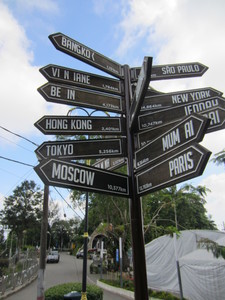
These signs in Penang/Malaysia were quite a good symbol for my trip.
I entered Laos from China, but I didn't spend a lot of time in Laos. The main reason was that I was quite frustrated with the weather. It was a comparatively cold winter in southern China and Laos and the buildings there are not really isolated at all and heating usually doesn't exist. While the days were all sunny and nice, the nights were sometimes quite tough. In Laos, usually the only mode of transport are buses and minibuses. I crossed the border at Houay Xai and quickly moved on to Bangkok by bus and train.
Travelling in Laos and Thailand was quite a different experience when compared to Kazakhstan and China. For the first half of my trip, I mostly felt like "the stranger going to places rarely visited by strangers". In China, even at touristy places there were mostly domestic tourists. Laos and Thailand are flooded with western tourists, so I was more like "the western guy going to places everyone else is going". Honestly, I felt much more comfortable with the first role. Malaysia was somewhat in-between. The most important thing I was looking for in this part of Asia was mostly nature and rainforests.
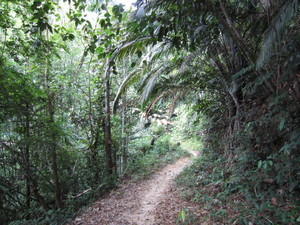
Rainforest in Malaysia.
If you know me, you know that I try to avoid flying. But it was clear that doing this trip without would be close to impossible. So I flew back from Kuala Lumpur in Malaysia earlier this week.
While I've seen a lot and experienced a lot, at the end I was at a point where I really didn't want to continue any more. I have a lot of respect and get inspiration from people people who consider themselves digital nomads, permanent travelers or something alike and I though a lot about that during travelling and in the months before. I'll probably write some more about that at a later point, as I find it quite desirable to organize life in a way to be less dependent on a fixed living spot. But for me, this has limits and I know where they are.
Posted by Hanno Böck
in English, Life
at
13:02
| Comment (1)
| Trackbacks (0)
Defined tags for this entry: asia, asia2013, kualalumpur, laos, malaysia, rainforest, thailand, travel
Tuesday, January 7. 2014
Boten - a chinese casino ghost town in Laos
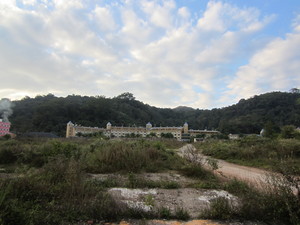
This hotel still takes customers, although there probably aren't many
Right behind the border in Laos is the small town Boten. There's a quite interesting story behind this place. A couple of years ago, this was a place of casinos for chinese gamblers. In China itself casinos are forbidden, so this gained quite some popularity. A couple of luxury Hotels and other facilities for the chinese gamblers emerged. However, some conflicts were arising. The casinos sometimes held chinese gamblers unable to pay their gambling debt as hostages. Chinese authorities were unhappy with this and pressured the laotian authorities to shut the place down, which finally happened in 2011.
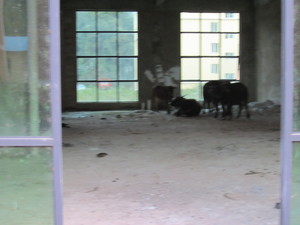
In this former hotel only cows sleep these days
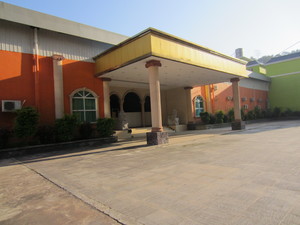
A Casino - empty today.
It was definitely one of the more interesting places on my trip.
Pictures from Boten
Saturday, December 21. 2013
Hallstatt in China
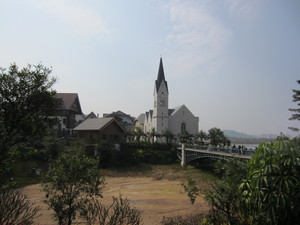
Hallstatt in China's Guangdong province
It was a bit tricky to get there. I found only limited information online. The place is near Luoyang, which is part of an area called Boluo, near the town Huizhou. Getting to Huizhou was mostly hassle-free, there are many trains every day from Guangzhou and it takes about two hours. How to come to Luoyang/Boluo is another story. I had two bus numbers I found in some Internet forums, but I couldn't find them at the train station. So either the information was wrong or the buses with that numbers are departing from another place in Huizhou. I also had some GPS coordinates I found online of the copycat Hallstatt, but it turned out later that they were not very accurate.

The entrance
What is interesting to know is that this place isn't primarily a tourist destination. It's a housing development, people are supposed to live here. However, I think nobody lives here yet, because except for the town's center, everything is still in construction. There are a number of similar projects in China. Tianducheng in eastern China, which rebuilts parts of Paris, has gotten quite a lot of media attention lately as an example for the Chinese housing bubble. Almost nobody lives there and it's mostly a ghost town. As the chinese Hallstatt isn't yet ready to house anyone, the future will tell if it'll fall to the same fate.
There were a number of things that made this place weird. The most obvious thing: You usually don't see tropical plants in an austrian town. I have no idea why they had a (fake/nonworking) red, british-style phone booth. Maybe for a chinese Britain isn't that far from Austria after all. Although this place isn't primarily meant as a tourist destination, it certainly attracts a lot of them. It was quite crowded. I haven't seen anyone who looked like being from Austria though.
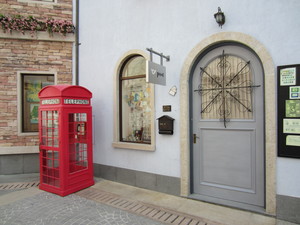
British style fake phone booth
I'd like to finish with a quick comment. When reading western news commenting about this case and others, they're often quick in condemning this kind of "copycat" culture. I think one needs to be careful with that. The importance of the "original" is something that is deeply rooted in cultural norms and traditions. Sticking to the original is something that's probably more important in European cultures than in China. But I don't think either of them is right or wrong, it's just a different approach to culture. After all, it doesn't hurt anybody if someone is rebuilding Austrian villages in China. Also, there is almost certainly no legal issue at stake here. While it may be debatable if a town's layout can be covered by copyright, Hallstatt is a historic city. So if there is any copyright on it, it's already expired.
Pictures from Luoyang
Pictures from Chinese Hallstatt
Some Links:
Blog entry about Hallstatt / China on thechinachronicle.com
Blog entry about Hallstatt / China on liongrass.hk
Friday, December 13. 2013
Fastest overland route from Europe to China
 The well-known way of getting from Europe to China overland is the transsiberian railway. However, I noted that the route through Kazakhstan I took is the quickest way to get to China by train and bus. I thought I'd write that up:
The well-known way of getting from Europe to China overland is the transsiberian railway. However, I noted that the route through Kazakhstan I took is the quickest way to get to China by train and bus. I thought I'd write that up:- Take train EC 43 from Berlin Hauptbahnhof (09:37 on Monday, Berlin time) to Warsaw Wschodnia, change to train D 10SZ (15:28). If you - like me - feel that the time to switch trains is a bit risky in case of delaqys, you can take the earlier Beriln-Warsaw-train EC 41 (06:37 until 12:08). There's also a direct Berlin-Moscow-train D 50472 (Berlin 04:28, Moskwa Belorusskaja 10:33), but it's often sold out early.
- Spend some time in Moscow and then take the Metro Line 5 (Circular Line) to Komsol'skaya (Metro of Kazasky railway station)
- Take train 090У from Moscow Kazansky (18:48 on Tuesday, Moscow time) to Petropavl/Petropavlovsk in Kazakhstan (09:46 on Thursday, Astana/Almaty time). Note that this only works every second Tuesday - you may choose other days where this train goes, but then other options may not work.
- Take train 152T from Petropavl (13:48 on Thursday, Astana/Almaty time) to Almaty (22:28 on Friday, Astana/Almaty time).
- Take bus number 100 to Sayran bus station and hope that they'll sell you a ticket late in the evening for the bus next morning. Find a place to sleep (but not very long).
- Take bus from Astana Sayran bus station (07:00 on Friday, Astana/Almaty time) to Yining (approx. 21:00 on Friday, Beijing time). You're in China.
With the transsiberian, you can leave Berlin on Monday (same options as above until Moscow) and take the D4ZJ direct train from Moscow to Beijing. You will enter China in Erlian on the next Monday at 00:47. So this makes almost 7 days vs. about 4 and a half days.
I wouldn't recommend anyone doing that. Better spend some time on the way and see some places in Russia or Kazakhstan. Also it should be noted that one obvious reason for being faster is that you'll enter China at a place much further in the west. And getting to the main part of china (the western part is much less inhabited than the eastern part and all big cities are in the east) can be somewhat troublesome. Still, I thought it might be of interest to document the fastest overland way from Europe to China.
I always assumed the starting point Berlin, obviously because I live there, adapting that to other starting places should be trivial. For example you can usually easily (and for a comparatively cheap price) reach Berlin by Eurolines bus in a day from other major european cities like Paris or London.
« previous page
(Page 4 of 23, totaling 335 entries)
» next page